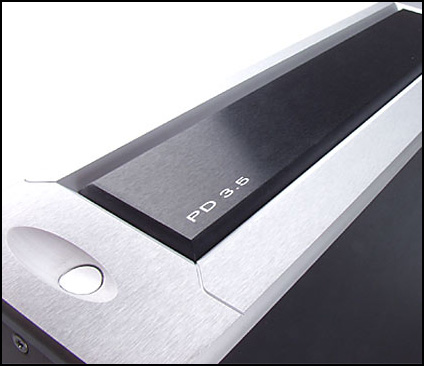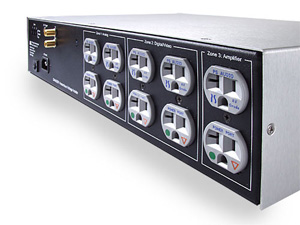You are reading the older HTML site
Positive Feedback
ISSUE
23
january/february
ps audio
Power Director 3.5
as reviewed by Larry Cox

|
LARRY COX'S SYSTEM
LOUDSPEAKERS
ELECTRONICS
SOURCE
CABLES
ACCESSORIES
|
My wife is a (mostly) willing participant in my disease… er, hobby. I do not have a dedicated room for my stereo system, so it is plunked in the middle of our living room, and I'm lucky that my wife is tolerant of the amount of space that it takes up. She enjoys music, but taking care with the system is not important to her, and she does not understand that observing the power-up and power-down rituals is important to the life of the gear. I've learned to be careful, but my wife comes from a world of entry-level Sony receivers and CD players and Bose loudspeakers, so I looked around for something that might make it easier for her to execute the necessary steps.
I found a few products that looked promising. Standing out from a crowded field was PS Audio's Power Director series. The Power Directors come in two iterations, the 3.5 and the 4.7. The "3" and "4" represent the number of high-current PS Audio Ultimate Outlet circuits per unit, and the "5" and "7" tell you how many duplexes per unit (with two receptacles for each). With only five components to plug in, the 3.5 seemed the best choice, and at $995 versus $1995 for the 4.7, the price made it more attractive. PS Audio's Angie Duran also sent a one-meter xStream Power Statement power cord, which retails for $499. Although far from free, the xStream Power Statement was a wonderful piece—very smooth and full sounding without taking away significant musical detail.
The Power Directors are very intelligent products, offering a load of features to make power to your system safe and your system safe from power. Many power conditioners work wonders on the AC feeding your system, but do very little to protect your gear from surges and spikes. The Power Directors don't just condition power, but do more—PS Audio has gone to great lengths to make things safe. The Power Director 3.5 has too many features to list, so I'm only going to write about the parts that tickled my fancy or which were relevant to my assessment of the unit's performance. PS Audio has done an exemplary job of providing information on its website, so go to www.psaudio.com/products/powerdirector35.asp if you need more information.
There is a lot of value inside the Power Director's casing. The first thing that attracted me to it was that I could stagger the timing of power to different receptacles. The three Ultimate Outlet circuits that you plug your gear into can be programmed to either be on "always on," to be switched on when the power to the Power Director is turned on (switched), or to turn on three seconds after the Power Director is powered up (switched but delayed). Putting my preamp in the switched position and the amps in the switched-but-delayed position allowed my wife to keep the peace and not have to remember the on/off cycle. We both liked that, yet it was merely a minor feature among many.
 The good stuff starts at the most basic level.
For starters, the Power Director provides an excellent physical connection for
your gear. The 3.5's receptacles get a gorilla grip on the electrical prongs. I
had to have someone hold the front of the unit while I pushed my plugs into the
back. That alone makes for better electricity, but things get more intricate
from there. The first line of protection in most power conditioners is a metal
oxide varistor (MOV). An MOV is a very reliable device, but its very reliability
is a problem. When too much voltage enters the circuit, it fails, keeping
electricity from moving into the system, but it can only fail catastrophically
once and then it doesn't work, and neither does your system. PS Audio solves
this problem by using Tranzorbers, which are high-speed clamping devices with
hundreds of thousands of safe "failures." Unlike MOVs, which allow only one
major arc, Tranzorbers allow multiple very small arcs of electricity to occur
when hit with a spike or surge. According to PS Audio, if a Tranzorber fails,
the next line of defense is "a fast acting relay-based 20 amp circuit breaker
[that] opens up the AC line and disconnects your equipment from possible
damage." If that fails, a reliable MOV is in line to stop the spread of unsafe
electricity. Of course, if both fail, you'll need to replace the MOV, but isn't
it nice to think how removed from problems you are?
The good stuff starts at the most basic level.
For starters, the Power Director provides an excellent physical connection for
your gear. The 3.5's receptacles get a gorilla grip on the electrical prongs. I
had to have someone hold the front of the unit while I pushed my plugs into the
back. That alone makes for better electricity, but things get more intricate
from there. The first line of protection in most power conditioners is a metal
oxide varistor (MOV). An MOV is a very reliable device, but its very reliability
is a problem. When too much voltage enters the circuit, it fails, keeping
electricity from moving into the system, but it can only fail catastrophically
once and then it doesn't work, and neither does your system. PS Audio solves
this problem by using Tranzorbers, which are high-speed clamping devices with
hundreds of thousands of safe "failures." Unlike MOVs, which allow only one
major arc, Tranzorbers allow multiple very small arcs of electricity to occur
when hit with a spike or surge. According to PS Audio, if a Tranzorber fails,
the next line of defense is "a fast acting relay-based 20 amp circuit breaker
[that] opens up the AC line and disconnects your equipment from possible
damage." If that fails, a reliable MOV is in line to stop the spread of unsafe
electricity. Of course, if both fail, you'll need to replace the MOV, but isn't
it nice to think how removed from problems you are?
Additionally, each of the Ultimate Outlets is isolated from the others, thus isolating each piece of equipment. The Power Director is said to perform AC conditioning as well as providing surge and spike protection. It is not current limiting, so it won't squelch macrodynamics during those evenings of Shostakovitch being played at 11. I never experienced any reduction in dynamics, despite having three power amplifiers hooked into the Power Director (two 100-watt E.A.R. 509 monoblock amplifiers and one 250-watt H2O digital stereo amplifier). With the 3.5's ten outlets, you can probably power most systems. I had outlets to spare.
The 3.5's build quality is excellent, as is its physical appearance. An industrial designer clearly spent time on the look and feel of the unit. Even its power cord differ from the re-badged Belden cables that dominate the rest of the market. Everything operated flawlessly over the four months I had the unit. This is a finished product. Everything looked great and did what it was supposed to do. Most important in our household, it was also easy to use.
PS Audio promises dramatic improvement to the sound. In my system, transient attacks were more obvious, decays lasted longer, and there was better separation of instruments. This may have been due to the fact that each Ultimate Outlet has up to 40dB of noise rejection, but the 3.5 certainly rendered more detail throughout the bandwidth than my reference API Power Wedge 116. When I was testing the Audiopath tonearm cables last month, I could more easily distinguish between these and other interconnects with the 3.5 than I could with my reference power conditioner. With my reference line conditioner, decays were truncated, attacks were not clearly delineated, and instruments blended into one another more than they did with the Power Director 3.5, although the 3.5 made the midrange ever so slightly more forward and more lean. While there was more detail, it was not spotlighted. The 3.5 made my system sound more transparent and detailed, but also made it sound a bit more forward. The sound was not brighter or whiter, but it was more immediate.
In a system that is more relaxed or darker sounding, or with a listener less attached to a relaxed sound, the Power Director 3.5 would probably sound tonally invisible, but my system could sound a bit more forward and vivid than I prefer. Although the forwardness showed up on only two tracks of one record, it was one of my favorite LPs, Linda Ronstadt's What's New. It manifested itself on two crescendos, making her voice sound hard. This might not show up in your system, but in mine, it did seem to indicate just a smidgeon of forwardness. The Power Director was an excellent match with the more relaxed sounding Audionet ART V2 CD player, so I can't say that the PS Audio sounds vivid or forward generally, just with my beloved analog setup. With CDs, attacks were very naturally portrayed, and midrange tonality was spot on, with the capacity to make me melt on favorite CDs. Bass was not only deep and full, but had excellent timbre.
At this point, digital is low on my priority list. I wallow in the joy of rediscovering my collection of LPs, so perfection in digital just isn't enough for me. The Power Director may be perfect in your system. I have only commenced looking for a new line conditioner, and the Power Director 3.5 is the first I've heard. If I were made of money, or someone wanted to lend me one, I'd have happily kept the Power Director 3.5, but alas, that didn't happen.
I was sorely tempted to purchase the Power Director 3.5. At first, my wife thought it retailed for $10,000, not $1000 and said NO, but when she discovered that it was "only" $1000, she said yes. I remain tempted by the excellent build quality, the belt-AND-suspenders electrical protection, and the ease of use of the 3.5, but before I plunk down my green, I want to hear what else is available. If I didn't have the luxury of trying before I buy, I probably would have purchased the 3.5, but it should be on many people's list of power conditioners. Larry Cox
Power Director 3.5
Retail: $995
PS Audio
web address: www.psaudio.com
